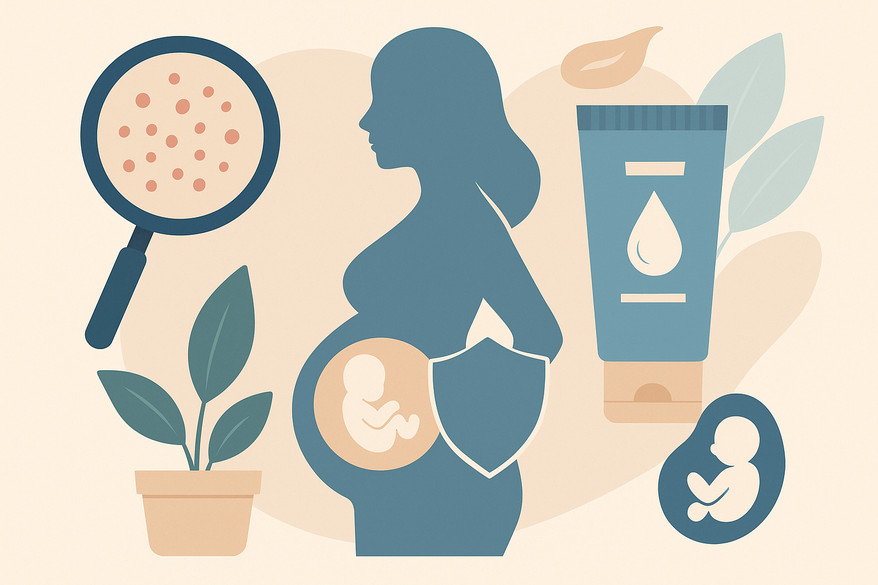Safe Rash Treatment During Pregnancy: A Comprehensive Guide for Expectant Mothers
Discover safe rash treatment during pregnancy to ease discomfort while ensuring safety for your baby. Learn effective remedies and preventive tips in this guide.

Estimated reading time: 8 minutes
Key Takeaways
- Safety first: Choose pregnancy-safe topical and oral treatments that protect both mom and baby.
- Know your rash: Identify eczema, PUPPP, heat rash, hives and other pregnancy-specific eruptions.
- OTC & prescription: Use fragrance-free moisturizers, colloidal oatmeal baths and low-potency steroids under guidance.
- Avoid risks: Steer clear of retinoids, high-dose ketoconazole and unverified herbal creams.
- Professional input: Always consult your obstetrician or dermatologist for tailored advice and monitoring.
Table of Contents
- Introduction
- Understanding Rashes During Pregnancy
- Safe Treatment Options
- Consultation and Professional Guidance
- Preventive Measures and Self-Care Tips
- Conclusion & Call to Action
- FAQ
Introduction
Balancing comfort and safety is essential when treating pregnancy-related rashes. Expectant mothers often face itchy bumps, red patches or hives, yet some topical and systemic drugs can cross the placenta or affect fetal development. With clear guidance, you can select remedies that relieve symptoms while safeguarding your baby’s health.
Understanding Rashes During Pregnancy
Hormonal fluctuations, immune shifts and increased blood flow can make pregnant skin more reactive. Common types include:
- Eczema
– A chronic inflammatory disorder causing dry, scaly, itchy patches on elbows, knees or torso.
– Hormonal changes may flare pre-existing eczema or trigger new cases.
– Source: Schweiger Dermatology - PUPPP (Pruritic Urticarial Papules and Plaques of Pregnancy)
– Intensely itchy hive-like lesions starting on the abdomen in late third trimester.
– Occurs in about 1 in 200 pregnancies.
– Sources: Medical News Today, Schweiger Dermatology - Heat Rash & Hives
– Heat rash (miliaria): blister-like bumps from trapped sweat.
– Hives (urticaria): raised wheals due to allergies or heat.
– Pregnancy can increase sweating and skin sensitivity.
– Source: Medical News Today - Allergic Reactions
– Localized redness, swelling or widespread itch from new skincare, detergents or foods.
– Always patch-test new products on the forearm for 48 hours. - Other Specific Rashes
– Pemphigoid Gestationis: autoimmune blistering needing dermatologist referral.
– Intrahepatic Cholestasis: intense itching on palms/soles indicating liver dysfunction.
– Source: Schweiger Dermatology
Safe Treatment Options
Over-the-Counter (OTC) Aids
- Fragrance-Free Moisturizers
– Hypoallergenic, ceramide-rich creams restore the skin barrier.
– Apply to damp skin 2–3 times daily.
– See top picks: fragrance-free moisturizer suggestions - Oatmeal Baths
– Colloidal oatmeal soothes inflammation and itch.
– Add 1 cup to a lukewarm bath; soak for 10–15 minutes.
– Learn more: oatmeal bath for rash - Oral Antihistamines
– Second-generation agents (loratadine, cetirizine) have minimal drowsiness.
– Use only after obstetrician approval.
Source: Healthline guide
Prescription Options
- Topical Corticosteroids
– Low- to medium-potency (e.g., triamcinolone 0.1%) for short courses.
– Monitor cumulative dose; avoid high-potency unless specialist-prescribed. - Oral Corticosteroids
– Reserved for severe PUPPP or autoimmune blistering diseases.
– Short-term prednisone with taper under close monitoring.
Sources: Schweiger Dermatology, Mount Sinai blog
Treatments to Avoid
- High-potency steroids without supervision
- Retinoids (tretinoin, isotretinoin)
- Tetracycline antibiotics
- High-dose ketoconazole
- Unverified herbal creams or essential oils
Source: Healthline guide
Consultation and Professional Guidance
Always start with professional input. Your obstetrician, dermatologist or midwife can confirm the diagnosis and tailor treatment to your gestational stage.
Red-flag symptoms needing urgent evaluation include:
• Severe, widespread rash covering large areas
• Fever, jaundice or pronounced swelling
• Signs of infection: pain, pus, warmth or expanding redness
Key questions for your provider:
- Is this treatment safe for my baby at my stage of pregnancy?
- Are there lower-absorption alternatives or purely topical options?
- What monitoring will be required (e.g., ultrasounds, blood tests)?
For ongoing monitoring, expectant mothers may find the AI-powered Rash Detector Skin Analysis App helpful for quick insights on rash images. Here’s a sample report:

Preventive Measures and Self-Care Tips
- Gentle Cleansing: Use pH-balanced, hypoallergenic formulas.
- Immediate Moisturizing: Apply emollients within three minutes of bathing.
- Short, Lukewarm Showers: Avoid long, hot showers that strip natural oils.
- Loose, Breathable Clothing: Opt for cotton or bamboo; avoid tight synthetics.
- Hydration: Drink 8–10 glasses of water daily.
- Good Hygiene: Keep nails trimmed; use soft washcloths to minimize scratching.
- Symptom Diary: Record daily triggers—foods, products or environments.
Conclusion & Call to Action
Effective management of pregnancy-related rashes relies on evidence-based, physician-approved strategies that relieve itch and inflammation while prioritizing fetal safety. From ceramide-rich moisturizers to low-potency corticosteroids and soothing home remedies, each approach centers on safety and relief. Always consult your healthcare provider for personalized guidance and seek immediate attention if red-flag symptoms arise.
Talk to your obstetrician or dermatologist today to create a personalized prenatal skin-care plan. For persistent or severe rashes, timely specialist evaluation is crucial to protect both you and your baby.
FAQ
- Q: Can I use topical steroids safely during pregnancy?
A: Yes, low- to medium-potency steroids are generally safe for short courses under medical supervision. - Q: Are natural remedies effective?
A: Gentle options like colloidal oatmeal baths and fragrance-free moisturizers can soothe mild rashes, but always discuss with your provider. - Q: When should I seek urgent care?
A: If you experience severe, widespread rash with fever, jaundice, intense swelling or signs of infection, seek immediate medical attention. - Q: How can I avoid future flare-ups?
A: Adopt preventive habits—use gentle cleansers, moisturize promptly, wear breathable fabrics and maintain a symptom diary to identify triggers.





